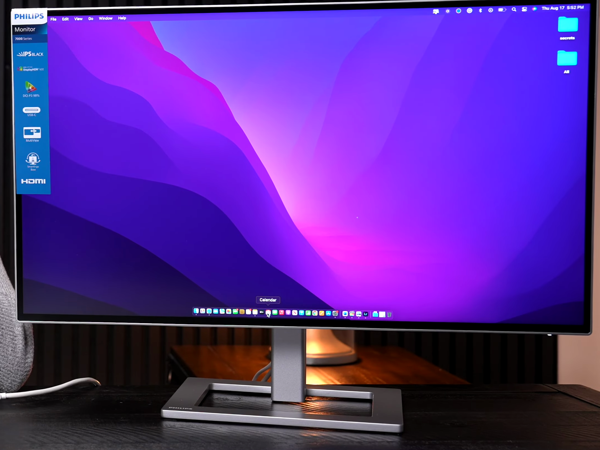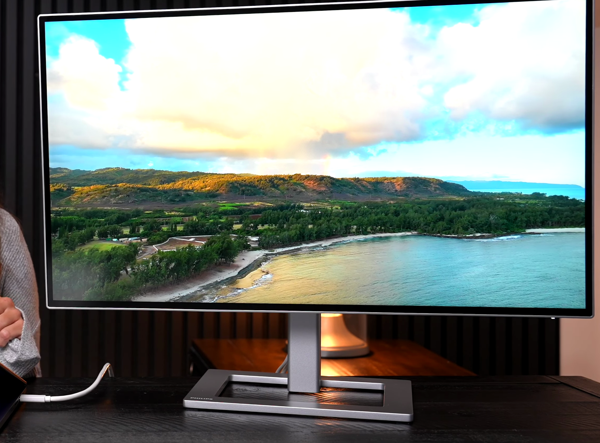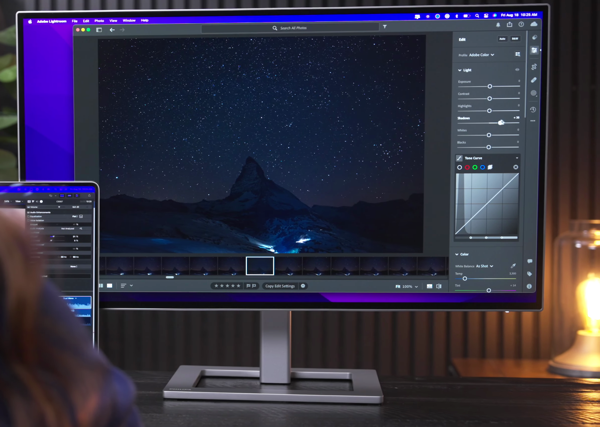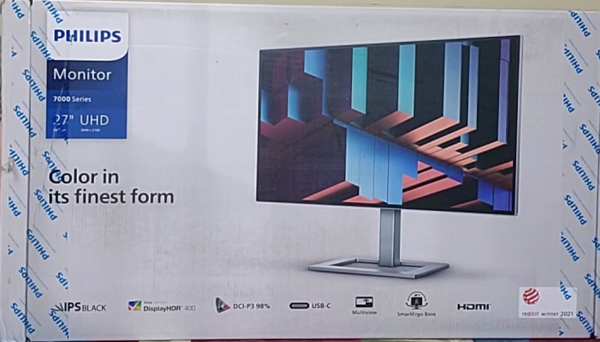Note: As an Amazon Associate I earn from qualifying purchases.
Review: My thoughts on using the PHILIPS 27E2F7901 27’ 4K UHD IPS Monitor (with USB-C) (2024)
Introduction
I recently purchased the Philips Creator Series 27E2F7901 monitor and have been extensively using it and testing its features. As a professional who deals with some video processing on a daily basis, color accuracy and a high screen resolution are essential for me. Below I discuss my experience with the monitor, covering the quality, design, one-cable docking convenience, and more.
Specifications
| Property | Value | Property | Value |
|---|---|---|---|
| Screen Size | 27 Inches | Display Resolution Maximum | 3840 x 2160 Pixels |
| Brand | PHILIPS | Special Feature | Height Adjustment, Anti Glare Screen, Hardware Calibration, Pivot Adjustment, Blue Light Filter,… |
| Refresh Rate | 60 Hz |
Photos
Click on photos to enlarge them:
Prices
Check prices of the PHILIPS 27E2F7901 27’ 4K Black Display on:
Striking Color Precision
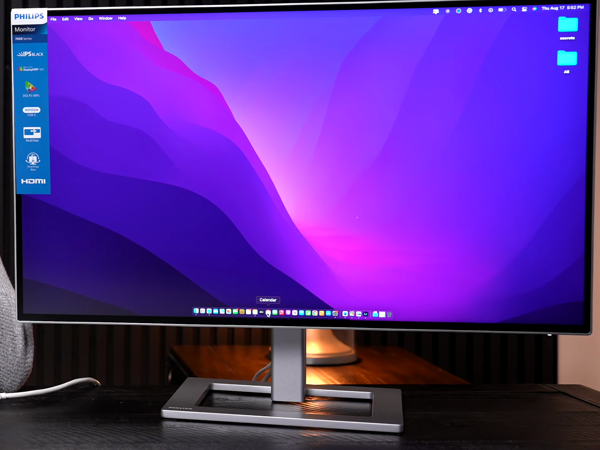
In my search for a monitor with excellent color accuracy, the Philips Creator Series 27E2F7901 stands out due to its IPS Black technology. This feature is crucial in delivering the contrast and color rendition required for graphic design work. The 4K resolution is impressive, providing a clear image with crisp details that significantly enhance visual content creation. Although calibrated out of the box, some color profiles required adjustments, which is a minor drawback.
Here’s a description of my experiences:
Pros:
IPS Black panel offers deep blacks and high contrast.
Color accuracy is excellent. A few minor adjustments are required.
The 4K UHD resolution produces crystal-clear images that are both sharp and vibrant.
Variety of color spaces, including Display-P3, is a boon for MacBook users.
Cons:
The menu interface is difficult to use, causing inconvenience for users.
Lack of built-in speakers may be a downside for some.
Despite the monitor’s impressive sRGB 100% and DCI-P3 98% coverage, the factory calibration did not meet my requirements. I had to adjust settings such as Gamma and Smart Contrast before the colors matched my professionally calibrated MacBook Pro display. It was a hassle, but necessary for the visual accuracy I need.
The absence of a simple menu is a disadvantage. Adjusting brightness should be easy, but this monitor makes it complicated. If you don’t change the settings frequently, this might not be an issue.
I’ve experienced significant challenges with the software designed for adjusting settings. Its tendency to be glitchy makes it unreliable and problematic, especially for those who heavily depend on software utilities. Regrettably, the display’s technological advancement is undermined by its glitchy firmware and accompanying software.
The IPS Black technology failed to truly blow me away in terms of contrast ratios. Although it offered an improvement in visual experience that was noticeable, it did not reach the depths of black that I have encountered with other displays, particularly OLEDs.
All considered, this monitor offers good value for its price range despite some issues with firmware and menu system. Its display quality is excellent for creative work, with precise colors and sharpness that enhance visuals. Despite software kinks, it’s worth considering for those seeking a monitor with comprehensive color support.
Ultimate One-Cable Convenience

The one-cable setup with the Philips Creator Series 27E2F7901 monitor is a significant improvement for my workflow due to its USB-C docking functionality. I no longer need to manage multiple cables for power, video, and data transfer. This simplifies my setup as follows:
Power Delivery: Provides up to 96W for charging my MacBook effectively, eliminating the need for an additional power brick.
Engaging in Data Transfer between my laptop and external storage is an uncomplicated process. By utilizing effective Data Transfer methods, I am able to effortlessly move files between devices. Data transfer is a crucial aspect of managing digital information, allowing seamless interaction between various devices and storage solutions.
Video Signal: Carries a high-resolution video signal from my laptop to the monitor, keeping my desk clutter-free.
Despite the monitor’s excellent single-cable feature, there is a notable lack of an included USB-C to USB-C cable, leading to audio issues during connection. This oversight has hindered my ability to fully utilize the monitor’s capabilities. Additionally, I have encountered reported audio problems that leave me confused and concerned, as even though I seldom use built-in monitor speakers, the unresponsive volume settings exacerbate these audio issues.
Looking beyond the convenience of cables, I encountered issues with the monitor’s firmware and software interface. The brightness adjustment was hard to reach in the menu, causing minor inconvenience over time. The software used to manage settings required improvement for a better user experience and to fix glitches.
Still, the IPS Black panel didn’t deliver the deep blacks I desired when compared to my laptop’s OLED display. The size disparity between a 27” monitor and a 13” laptop screen also influenced my assessment of quality.
I can’t ignore the convenience of the one-cable setup for my daily work. Eliminating the need for additional adapters and simplifying my desktop setup is crucial for maintaining an orderly and efficient workspace. However, Philips needs to resolve a few issues in future updates or models for this monitor to be perfect.
The allure of an OLED monitor for my next desktop purchase is strong, despite Philips’ current software issues. The cost-effectiveness, when on sale and considering its price performance, tips the scale in its favor. I find it enticing, especially due to its accurate color reproduction and seamless integration with my MacBook’s display through simple settings adjustments.
Striking a balance is crucial for this monitor’s success. It offers the convenience of a single cable setup, while effectively addressing software complexities. This combination appeals to users seeking an efficient and clutter-free workspace.
Productivity Meets Flexibility

When using monitors designed for increased productivity, the Philips Creator Series 27E2F7901 has impressed me significantly. The focus is not only on screen space but also on facilitating an efficient workflow. Here are some notable aspects of my experience with it:
The large 27-inch 4K UHD display offers ample space for running multiple applications.
KVM switch allows me to use one keyboard and mouse to control two separate computers.
DisplayPort Daisy-Chaining enables an extended multi-monitor setup by connecting multiple displays directly from one DisplayPort output to the next.
My workday relies heavily on a monitor boasting a high-performance 3840 x 2160 resolution. This advanced resolution is indispensable as it enables me to keep multiple windows open side by side without sacrificing detail or requiring frequent window switches. The monitor’s built-in KVM switch further optimizes my setup, offering the convenience of effortlessly toggling between my personal laptop and work desktop with just one button. This invaluable feature eliminates the need for time-consuming cable and peripheral swaps.
Yet, productivity isn’t solely about the number of pixels on the screen. Philips’ implementation of DisplayPort Daisy-Chaining is noteworthy. This feature reduces clutter on your desk by requiring fewer cables and allows for a wider view when using multiple monitors. However, navigating the OSD menu could be more intuitive. The process of adjusting settings can interrupt workflow.
On the downside, the monitor’s color pre-calibration needs adjustment. This is disappointing, considering its appeal to creatives. You may need to spend time customizing settings for an ideal display.
The other issue I encountered was the absence of built-in speakers. This might not be an issue for me since I prefer using headphones, but it could be a drawback for users seeking a complete multimedia experience.
Equipping my workspace with this Philips monitor has been mainly beneficial. However, there are some areas where the monitor could use improvement, particularly in its non-intuitive menu and the software that could use some refinement. Despite these drawbacks, the advantages surpass the disadvantages. It’s now a vital tool in enhancing my work efficiency and productivity.
Notable Design and Ergonomics

Navigating monitor designs and ergonomics can be challenging for some, including me. The Philips Creator Series 27E2F7901 monitor presents similar complications. Here are my observations:
Design: The monitor’s frameless design is contemporary and suits any workspace. Its 27-inch screen size permits multitasking effectively without overwhelming the desk area.
The stand’s adjustability features offer a full range of motion, enabling effortless modifications in height, tilt, pivot, and swivel. With this extensive flexibility, finding an optimal angle for various tasks is both convenient and productive.
Build Issues: The screen may bend under pressure, indicating potential Build Issues and durability concerns for the device in the future.
The sleek design is notable. The narrow bezel provides a nearly uninterrupted view, which is beneficial for design enthusiasts. However, some concerns emerge upon closer inspection. The screen’s flexibility, due to the absence of front glass, raises questions about its durability in the long run. Nevertheless, these issues are more cause for caution than reasons to dismiss, given the monitor’s overall strong construction.
One cannot ignore the stand’s adaptability. Adjusting its height and tilt enhances my workspace’s ergonomics. Changing from portrait to landscape mode is useful, particularly for coding or handling lengthy documents.
On the downside, the user interface is not user-friendly. Accessing common settings like brightness requires extra steps. The absence of built-in speakers may be a drawback for some users, although I usually prefer external audio systems for better sound quality.
In conclusion, the Philips 27E2F7901 monitor excels in design and aesthetics, making it an appealing addition to any setup. Its adjustable stand offers flexibility, enhancing its user-friendliness. Although I value the monitor’s visual detail, I have concerns about its slightly complex menu and build quality.
Despite slight drawbacks, this monitor is a strong contender for those prioritizing screen real estate and visual fidelity. Regardless of whether you’re working with numbers at the office or editing high-resolution videos at home, the advantages of a well-built display are significant.
